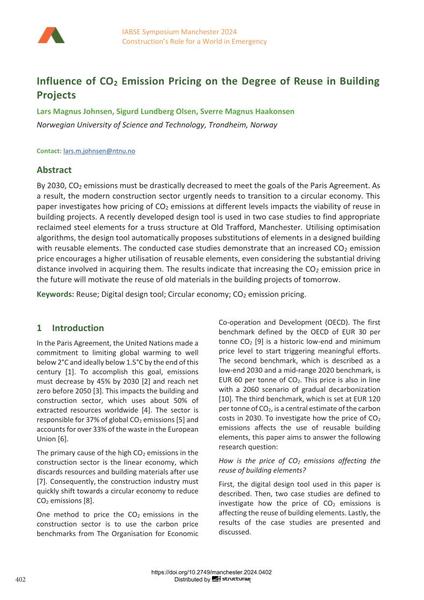Influence of CO₂ Emission Pricing on the Degree of Reuse in Building Projects

|
|
|||||||||||
Bibliografische Angaben
| Autor(en): |
Lars Magnus Johnsen
(Norwegian University of Science and Technology, Trondheim, Norway)
Sigurd Lundberg Olsen (Norwegian University of Science and Technology, Trondheim, Norway) Sverre Magnus Haakonsen (Norwegian University of Science and Technology, Trondheim, Norway) |
||||
|---|---|---|---|---|---|
| Medium: | Tagungsbeitrag | ||||
| Sprache(n): | Englisch | ||||
| Tagung: | IABSE Symposium: Construction’s Role for a World in Emergency, Manchester, United Kingdom, 10-14 April 2024 | ||||
| Veröffentlicht in: | IABSE Symposium Manchester 2024 | ||||
|
|||||
| Seite(n): | 402-408 | ||||
| Anzahl der Seiten (im PDF): | 7 | ||||
| DOI: | 10.2749/manchester.2024.0402 | ||||
| Abstrakt: |
By 2030, CO₂ emissions must be drastically decreased to meet the goals of the Paris Agreement. As a result, the modern construction sector urgently needs to transition to a circular economy. This paper investigates how pricing of CO₂ emissions at different levels impacts the viability of reuse in building projects. A recently developed design tool is used in two case studies to find appropriate reclaimed steel elements for a truss structure at Old Trafford, Manchester. Utilising optimisation algorithms, the design tool automatically proposes substitutions of elements in a designed building with reusable elements. The conducted case studies demonstrate that an increased CO₂ emission price encourages a higher utilisation of reusable elements, even considering the substantial driving distance involved in acquiring them. The results indicate that increasing the CO₂ emission price in the future will motivate the reuse of old materials in the building projects of tomorrow. |
||||
